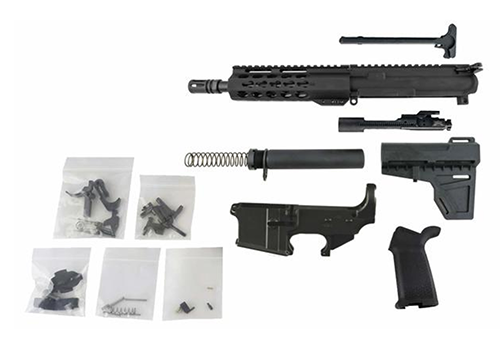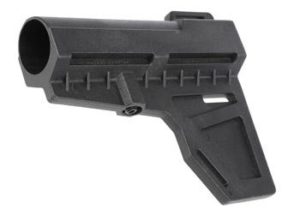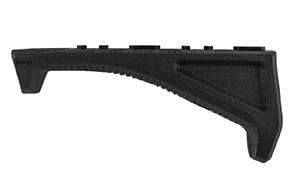What the Hell is an AR-15 Pistol Anyway?
Posted by Gun Builders Depot on Apr 16th 2018
The AR-15 pistol is essentially handgun built using AR-15 rifle parts (like these AR pistol kits). An AR pistol uses the same upper and lower receiver, lower parts kit, buffer system, and bolt carrier group as a black rifle. So what's the difference? AR-15 pistols are often much smaller than standard rifles.
They use shorter barrels, too -- 7.5"" is the common length for .223 or 5.56 cartridges. An AR pistol in 9mm can come with something as short as a 4-inch barrel, though.
Want to build one, legally, using an 80 lower receiver? Keep reading:
How the Law Defines the AR-15 Pistol
An AR-15 pistol is an AR-15 that has a barrel shorter than 16 inches, does not have a stock, and is shorter than 26 inches overall. The lack of a stock defines the AR pistol as a pistol.
If you equip an AR-15 platform of any caliber with a barrel shorter than 16 inches and a stock, it becomes a short-barreled rifle (SBR).
A short-barreled rifle is legal to own in most states but requires the user to go through the NFA process, register the weapon, and pay a 200-dollar tax stamp.
An AR pistol allows the user to have a barrel shorter than 16 inches, without having to go through the NFA process. Some states will prohibit the ownership of short-barreled rifles regardless of the Federal law. This makes an AR-15 pistol the only option for someone wanting a short barrel AR-15.
Although the standard AR pistol fires a rifle round and feeds from rifles magazines, it is still a pistol based on the ATF's definition of a pistol. So even though it delivers rifle performance, it's lack of a stock, it's short barrel, and overall length makes it a pistol.
How to build an AR-15 pistol

You need to start fresh and you'll need to start an AR-15 lower receiver. Lower receiver manufacturers do not label their receivers pistol or rifle anymore.
A receiver is sold as a receiver, not specifically as a pistol or rifle, so you can purchase any receiver to turn it into a pistol. If you are interested in using an 80% lower receiver the federal law permits it and it's a hell of a lot of fun.
Building an AR pistol is often the exact same as building a rifle. There are a few key differences. First, you must use a AR-15 pistol buffer tube, and/or an AR-15 pistol buffer tube assembly.
A pistol buffer tube does not allow the user to attach a stock. If you build your own upper receiver you will need a pistol length gas system. That is where the main difference between building a pistol and a rifle ends.
However there are numerous AR-15 pistol upper assemblies available to buy if you want the convenient route
Keeping Your AR Pistol Legal (what not to do)
When building an AR-15 pistol you cannot convert a rifle into a pistol. So you cannot take your existing rifle and turn it into a pistol. However, after you build your AR pistol you can later convert that into a rifle, and then back to a pistol legally.

You cannot add a stock, but you can add a variety of accessories to make the weapon easier to shoot. You can equip a Thordsen cheek rest to, you guessed it, rest your cheek and use proper sights. You can also equip a SIG SBX Pistol Stabilizing Brace or a KAK Shockwave Blade Pistol Stabilizer that you use to brace the weapon on your arm or use as a cheek rest. You cannot shoulder any of these items, or the weapon becomes a short barreled rifle according to the ATF.
No Vertical Foregrips Allowed
You cannot equip your AR-15 with a vertical foregrip if it is a pistol. You can, however, use an angled foregrip. The Magpul angled foregrip is completely legal to use on a pistol and can greatly increase the control you have over the weapon.

If you only own an AR pistol it may be prudent not to own any AR-15 stocks. Even if it is never equipped on the weapon you may find yourself in hot water due to something called constructive possession.
However, if you already own an AR-15 rifle, or even a 16-inch upper receiver assembly you have a legitimate reason to own a stock.
Some states restrict your ability to carry a weapon with a concealed carry permit to a pistol. This includes how you carry the weapon in a vehicle. When you possess an AR-15 pistol it does allow the user to store it as a pistol in their vehicle. Many prefer a larger platform to deal with more serious situations, and the AR Pistol is just that!
Why Build an AR Pistol at All?
Lastly, AR-15 pistols can be a ton of fun. They create a vivid fireball when fired, a helluva lot of noise, and they are smaller and lighter than their rifle counterparts. They are easier to maneuver, and allow you to create a unique weapon.
Staying legal is easy, and if ever in doubt you can actually write the ATF for clarification one accessory or another.
If you have any questions about building an AR pistol or the legalities around it, don't hesitate to contact us.
DISCLAIMER: If you are new to the world of DIY gun building, you likely have a lot of questions and rightfully so. It’s an area that has a lot of questions that, without the correct answers, could have some serious implications. At GunBuilders.com, we are by no means providing this content on our website to serve as legal advice or legal counsel. We encourage each and every builder to perform their own research around their respective State laws as well as educating themselves on the Federal laws. When performing your own research, please be sure that you are getting your information from a reliable source.

